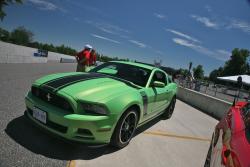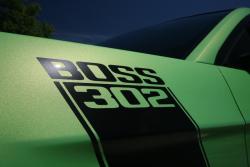 2013 Ford Mustang Boss 302. Click image to enlarge |
|
First Drive: 2013 Ford Shelby GT500
Manufacturer’s web site |
Review and photos by James Bergeron
Photo Gallery:
2013 Ford Mustang
Some will argue that the 2013 Shelby GT500 with its 662-hp supercharged engine is the best Mustang you can buy. For some, that is, perhaps, the truth. But the 2013 Ford Mustang Boss 302 is no slouch and is arguably faster around a racetrack, with its lighter front end, track-tuned suspension, and race-inspired drivetrain.
For 2012 Ford wanted to prove that the Boss 302 could perform, and for 2013 they focused on taking that performance to a new level by enhancing its looks and celebrating its history. The 2013 Mustang Boss 302 is a throwback to the iconic 1970 Boss 302 and builds on the heritage of that car with its new hockey-stick graphics package that features reflective stripes and new School Bus Yellow paint honouring Parnelli Jones’ 1970 Trans-Am championship car.
With a starting MSRP of $48,799, the Boss 302 is more than ten grand less than a GT500, yet offers similar track performance despite its lack of grunt. The 302 may not have 662 hp, but it does have a very respectable 444 horsepower and 380 lb-ft of torque developed by a 5.0L V8 engine.
Power is delivered to a 3.73-ratio rear axle using carbon-fibre plates in the limited-slip differential to improve handling and longevity. For those who want even more precise control over power delivery, a torque-sensing (Torsen) limited-slip differential is available, along with Recaro front seats. And of course the Boss 302 is available only with a six-speed manual transmission.
 2013 Ford Mustang Boss 302. Click image to enlarge |
The reflective stripes on the Boss come to life when lights hit them, similar to how they did in 1970 on that Mustang Boss 302. The new stripe follows the classic hockey stick motif by going over the fender and extending down the body panel.
Similar to the redesigned base Mustang lineup, the front end offers a more powerful design with a more prominent grille. A more aggressive splitter and functional hood extractors reinforce that look. The Boss Mustang has new signature lighting, with standard HID headlamps and LED-surround taillamps.
The 2013 Boss also offers a unique functional design feature in the grille, with removable covers where fog lamps would be. For improved cooling on track days, the covers can be easily removed with a screwdriver.
Additionally, the rear end features a high-gloss black panel that connects the taillamps. The taillamps have smoked lenses that match up with the sinister front end.
In keeping with the Boss mandate to provide the best-handling Mustang ever, the already strong Mustang GT suspension system has been further refined. Higher-rate coil springs on all four corners, stiffer suspension bushings and a larger-diameter rear stabilizer bar all contribute to the road racing mission, and Boss models are lowered by 11 mm in front and 1 mm at the rear versus Mustang GT. But the real key to handling is in the adjustable shocks and struts, standard on all Boss Mustangs.
   2013 Ford Mustang Boss 302. Click image to enlarge |
Finishing off the 302 package are lightweight 19-inch black alloy racing wheels with Pirelli PZero summer tires—255/40R19 up front and 285/35R19 in the rear to ensure that the power is delivered to the pavement smoothly and properly.
Being able to drive a fast car fast has a lot to do with comfort and feel, so the Boss 302 offers a smaller steering wheel wrapped in Alcantara that gives the driver the feel they need to turn in with confidence while the Recaro seats hold you snug around those high-speed corners.
Driving the GT500 and the Boss 302 back to back on the racetrack it was evident that although the GT500 has more power than one could ever need, it was the Boss 302 that was the true driver’s car with a balanced chassis, just enough power to be useful, and tons of grip in the corners.
Despite the Mustang being a large and heavy vehicle, the Brembo four-piston calipers acting on 355-mm (14-inch) vented rotors up front and the standard rear Mustang GT brakes (upgraded with a Boss-specific high-performance pad compound) proved to be more than sufficient, even after multiple laps by journalists who were overusing them. (You mean, journalists who can’t handle a race car like you can? –Ed.) Up front, vented brake shields and a reprogrammed ABS system specific to the Boss offer repeatable fade-free stops.
For those that want to, uh, track their performance, the “Track Apps” integrated into the centre gauge cluster offer performance metrics for drivers. The screen displays braking performance, measures g-forces and records acceleration times, and offers drag-like countdown starts.
There is no question in my mind that the Boss 302 is the ultimate Mustang for the track despite its “lack” of power compared to the Shelby. The Boss’ balance of power and chassis dynamics make it a track star and, for my money, the best Mustang to date.














